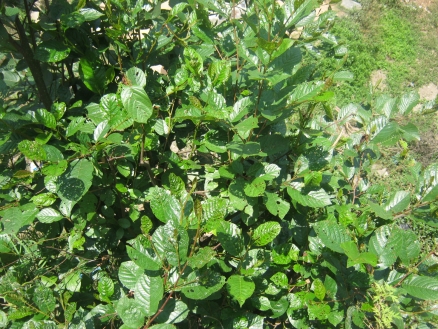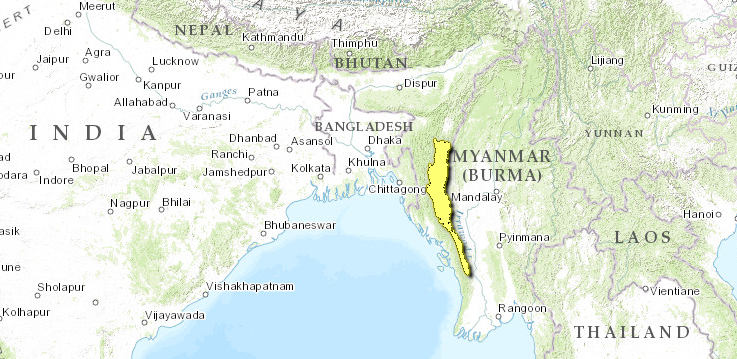Chin Hills-Arakan Yoma montane forests
Introduction The Chin Hills-Arakan Yoma Montane Rain Forests are globally outstanding for bird richness (Chin Hills-Arakan Yoma montane forests) , partly because they acted as a refugia during recent glaciation events. This ecoregion still harbors many taxa characteristic of the Palearctic realm and a diverse (Species diversity) assemblage of subtropical species distributed across its elevational gradients. Much of the southern Chin Hills remains biologically unexplored.
Location and General Description
This ecoregion represents the montane moist forests along the length of the Chin Hills and Arakan Yomas mountain ranges along the west coast of Myanmar. The Köppen climate zone classifies this ecoregion in the tropical wet climate zone.
Below 1,000 meters (m) the vegetation is characterized by several canopy dominants, such as Bauhinia variegata, Lagerstroemia speciosa, Derris robusta, Ficus spp. Hibiscus, and Strobilanthes. Mature forests are richly draped with lianas, especially Congea tomentosa and Mucuna pruriens. Between 1,000 and 2,100 m, the mixed evergreen broadleaf forest is composed of Quercus spp., Castanopsis spp., Eugenia, Saurauia, Eriobotrya, and Schima. Above 2,000 m, the forest is dominated by Himalayan tree taxa such as Alnus nepalensis, Betula alnoides, Carpinus, Prunus, Pyrus, and Torreya, and these transition into Castanea, Cornus, Eriobotrya, Laurus, and Taxus at higher elevations. Epiphytes are numerous in this montane cloud forest environment and include Aeschynanthus, Agapetes, Rhododendron cuffeanum, various aroids, and the orchid taxa Dendrobium and Pleione. Quercus xylocarpa is the dominant oak between 2,400 and 2,750 m, whereas Rhododendron arboreum and Q. semecarpifolia are dominant above 2,750 m. At the highest altitudes (c. 3,000 m) the forests become shrubby, with the vegetation consisting of Hypericum patulum and Rhododendron burmanicum, and the herbaceous plants include Aconitum, Lactuca, Pedicularis, and Veronica. In some areas, the summit ridges are covered by a temperate savanna composed of various shrubs such as Rhododendron spp., Buddleja spp., Daphne spp., Leycesteria spp., and Lonicera spp., as well as tall grasses and herbs such as Aconitum, Delphinium, Geranium, and Thalictrum.
Biodiversity Features
The summit of Natma Taung (Mt. Victoria), in northwest Myanmar, is a southern enclave of the Palearctic temperate flora and a refugium for several species such as Geranium spp. Lilies such as Lilium wallichianum also occur on these slopes, and large areas are covered by communities of alpine forbs. Besides presenting an island of Himalayan alpine vegetation at tropical latitudes, this high-altitude, isolated mountain contains many endemics above 1,800 m. Examples include Rhododendron burmanicum, R. cuffeanum, Agapetes unwinii, Viola unwinii, Mantisia wardii, Geranium wardii, Roscoea australis, Agrostis burmanica, A. mackliniae, Apocopis anomalus, and Tripogon wardii. Tetracentron sinense, a CITES-listed species, is one of the species that remained in this important refuge. Although the southern portion of this ecoregion is poorly known botanically, the Rongklang Range is known to be the only site in Myanmar for plants such as Trichodesma khasianum and Pyrus khasiana.
|
Table 1. Endemic and Near-Endemic Bird Species. Family Common Name Species Sittidae White-browed nuthatch Sitta victoriae * Timaliidae Striped laughingthrush Garrulax virgatus Timaliidae Brown-capped laughingthrush Garrulax austeni An asterisk signifies that the species' range is limited to this ecoregion. This ecoregion overlaps with a Level I Tiger Conservation Unit (TCU) and the Eastern Himalayas Endemic Bird Area (EBA) (130). Mammal species of conservation significance in this ecoregion include the threatened and endangered Hoolock gibbon (Hylobates hoolock), tiger (Panthera tigris), clouded leopard (Pardofelis nebulosa), leopard (Panthera pardus), sun bear (Ursus malayanus), thamin (Cervus eldii), and gaur (Bos gaurus). There are no endemic mammals. This ecoregion (Chin Hills-Arakan Yoma montane forests) contains three endemic bird species: the striped laughingthrush (Garrulax virgatus), brown-capped laughingthrush (Garrulax austeni), and white-browed nuthatch (Sitta victoriae) (Table 1). ==Current Status== {| border="1" cellpadding="3" align="right" ! colspan="3" | Table 2. WCMC (1997) Protected Areas That Overlap with the Ecoregion. Protected Area Area (km2) IUCN Category Natma Taung 300 PRO Ecoregion numbers of protected areas that overlap with additional ecoregions are listed in brackets. This ecoregion (Chin Hills-Arakan Yoma montane forests) is in good condition, with about two-thirds of the forest intact. Most of the clearing (Deforestation) has taken place in northern and central Myanmar, where the primary climax vegetation, below about 2,500 meters (m), has been almost eliminated. One proposed protected area covers about 1 percent of the ecoregion. ==Types and Severity of Threats== Shifting cultivation, locally known as taunggya, is the most serious threat to the remaining undisturbed natural vegetation. Although this system once caused minimal damage, increasing population pressure has forced farmers deeper into the forest and reduced the time allowed for the cycle. When the fallow period is too short to permit forest regrowth, secondary bamboo scrub results. Hunting and habitat loss have led to the local extinctions of several mammals in recent times, including the gaur (Bos gaurus), elephant (Elephas maximus), and rhinoceros. ==Justification of Ecoregion Delineation== MacKinnon's westernmost subunit (09c) represents a transition zone between the Indian Subcontinent and Indochina bioregions and is essentially made up of forest formations belonging to the tropical moist forests biome. We included the montane forests of the rugged and highly dissected Chin Hills and Arakan Yomas in a distinct ecoregion: Chin Hills-Arakan Yoma Montane Rain Forests. This ecoregion overlaps with a Level I TCU, the Eastern Himalayas (130) EBA. ==Additional information on this ecoregion== * For a shorter summary of this entry, see the WWF WildWorld profile of this ecoregion. * To see the species that live in this ecoregion, including images and threat levels, see the WWF Wildfinder description of this ecoregion. * World Wildlife Fund Homepage |
|---|

